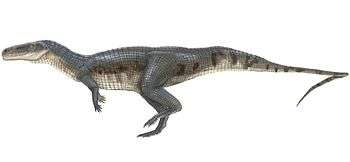Erpetosuchidae
| Erpetosuchidae Temporal range: Middle - Late Triassic, Anisian–Norian | |
|---|---|
 | |
| Life restoration of Erpetosuchus granti | |
| Scientific classification | |
| Kingdom: | Animalia |
| Phylum: | Chordata |
| Class: | Reptilia |
| Clade: | Pseudosuchia |
| Family: | †Erpetosuchidae Watson, 1917 |
| Subgroups | |
Erpetosuchidae is an extinct family of pseudosuchian archosaurs. Erpetosuchidae was named by D. M. S. Watson in 1917 to include Erpetosuchus.[1] It includes the type species Erpetosuchus granti from the Late Triassic of Scotland, Erpetosuchus sp. from the Late Triassic of eastern United States and Parringtonia gracilis from the middle Middle Triassic of Tanzania;[2] the group might also include Dyoplax arenaceus from the Late Triassic of Germany.[3]
Description
Three synapomorphies or shared characteristics were identified for Erpetosuchidae: teeth restricted to the anterior half of the maxilla, a posterior half of the maxilla that is thicker than it is tall, and no tooth serrations. Other possible synapomorphies of the two taxa not yet sampled in the cladistic analysis were considered tentative. Both taxa share a sharp ridge on the lateral margin of the maxilla that marks the ventral extent of the antorbital fossa. Ventral to this ridge, the external surface of the maxilla is inclined medially towards the alveolar margin. In Erpetosuchus, this medially inclined external surface of the maxilla continues posteriorly onto the jugal, exposing much of the external surface of the jugal in ventral view. This morphology unites the North American and European specimens of Erpetosuchus with Parringtonia gracilis. Other potential synapomorphies include a hypertrophied tuber hypothesized for the attachment of the m. triceps brachii on the posterolateral surface of the proximal scapula blade. Unlike other archosauriforms that have a small tuber in the same location, the size of the tuber in erpetosuchids is exceptionally large in relation to the overall size of the scapula. Furthermore, as Krebs (1976) hypothesized the scapula blade slightly arc anteriorly in both taxa. However, this condition is similar to that of other archosaurs, like Postosuchus kirkpatricki. Both Parringtonia and Erpetosuchus have a groove that runs along the top of the neural arch of each vertebra.[2]
While Erpetosuchus granti and Erpetosuchus sp. are nearly indistinguishable, the scapula of Parringtonia differs from E. granti in that it has a small bump or tubercle over its shoulder socket, osteoderms that are nearly square instead of being anteroposteriorly longer than wide, and a foramen (or hole) on the outer surface of the maxilla. Parringtonia has five tooth sockets, Erpetosuchus gracilis only four, and Erpetosuchus sp. six or more (up to nine). Furthermore, Erpetosuchus sp. has a proportionally taller ascending process of the maxilla than Parringtonia.[2]
Phylogeny
Erpetosuchidae is a stem-based taxon first defined by Nesbitt & Butler (2012) as "the most inclusive clade containing Erpetosuchus granti but not Passer domesticus, Postosuchus kirkpatricki, Crocodylus niloticus, Ornithosuchus longidens or Aetosaurus ferratus". A phylogenetic analysis conducted by Nesbitt & Butler (2012) showed that Parringtonia gracilis and Erpetosuchus granti form a well-supported clade (Erpetosuchidae) within Archosauria. This analysis was based on a modified version of Nesbitt (2011) analysis, the most extensive early archosaur phylogeny to date. The results of this analysis were very similar to those of Nesbitt (2011). However, the addition of Parringtonia and Erpetosuchus decreased resolution at the base of Archosauria and resulted in a strict consensus tree with a large polytomy or unresolved evolutionary relationship. This polytomy contained Erpetosuchidae, Avemetatarsalia, Ornithosuchidae, Aetosauria and Revueltosaurus clade, Ticinosuchus and Paracrocodylomorpha clade, Gracilisuchus, and Turfanosuchus. Of the other trees produced in the analysis, Erpetosuchidae takes six possible phylogenetic positions within Archosauria. Five out of six are within the Pseudosuchia, meaning that Parringtonia and Erpetosuchus are probably crocodile-line archosaurs as was previously thought. However, none of the possible positions are within the Paracrocodylomorpha, meaning that Parringtonia and Erpetosuchus are not closely related to Crocodylomorpha. Below are the possible positions within Nesbitt's phylogeny, marked by dashed lines:[2]
| Archosauromorpha |
| ||||||||||||||||||||||||||||||||||||||||||||||||||||||||||||||||||||||||||||||||||||||||||||||||||||||||||||||||||||||||||||||||||||||||||||||||||||||||||||||||||
| |
The exclusion of Gracilisuchus and Turfanosuchus results in a more resolved topology, placing Erpetosuchidae at the base of Suchia as the sister taxon of aetosaurs plus Revueltosaurus clade. This relationship is weakly supported by only the two character states: posterior portion of the maxilla ventral to the antorbital fenestra expands dorsoventrally and two paramedian pairs of osteoderms. When E. granti was solely used to represent Erpetosuchidae, Gracilisuchus and Turfanosuchus were recovered as basal suchians, in polytomy with Ticinosuchus plus Paracrocodylomorpha and E. granti plus (aetosaurs plus Revueltosaurus) clade. Below is a cladogram after the exclusion of Gracilisuchus and Turfanosuchus (Avemetatarsalia, Loricata and Poposauroidea have been collapsed).[2]
| Archosauromorpha |
| ||||||||||||||||||||||||||||||||||||||||||||||||||||||||||||||||||||||||||||||||||||||||||||||||||||||||||||||||||||||||||||||||||||
| |
References
- ↑ Benton, M. J.; Walker, A. D. (2002). "Erpetosuchus, a crocodile-like basal archosaur from the Late Triassic of Elgin, Scotland". Zoological Journal of the Linnean Society. 136: 25–47. doi:10.1046/j.1096-3642.2002.00024.x.
- 1 2 3 4 5 Nesbitt, S. J.; Butler, R. J. (2012). "Redescription of the archosaur Parringtonia gracilis from the Middle Triassic Manda beds of Tanzania, and the antiquity of Erpetosuchidae". Geological Magazine: 1. doi:10.1017/S0016756812000362.
- ↑ Michael W. Maisch; Andreas T. Matzke; Thomas Rathgeber (2013). "Re-evaluation of the enigmatic archosaur Dyoplax arenaceus O. Fraas, 1867 from the Schilfsandstein (Stuttgart Formation, lower Carnian, Upper Triassic) of Stuttgart, Germany". Neues Jahrbuch für Geologie und Paläontologie - Abhandlungen. 267 (3): 353–362. doi:10.1127/0077-7749/2013/0317.



